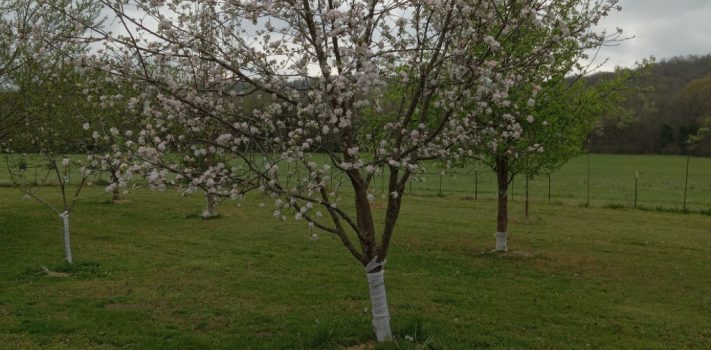Late winter into early spring is usually the time for planting, pruning, and getting trees ready for the coming summer. Since trees and maintenance services are usually expensive, you need to know how to do this for yourself. If you are thinking about planting new trees in the next 6 to 18 months, then now is the time to prepare. Purchases from a tree nursery must often be planned months in advance. Some nurseries take pre-orders a year ahead.
 Whether you are planting a fruit tree, a nut tree, a deciduous shade tree, or an evergreen tree for privacy and wind reduction, the planting process is more than just digging a hole in the ground and dropping it in. My grandfather spent time planting trees for shelter belts during the Great Depression, when the wind picked up loose topsoil to create the Dust Bowl. Some of those shelter belts can still be seen around Nebraska and Kansas to this day, although many are poorly maintained. That is sad! Proper planting and spacing is essential.
Whether you are planting a fruit tree, a nut tree, a deciduous shade tree, or an evergreen tree for privacy and wind reduction, the planting process is more than just digging a hole in the ground and dropping it in. My grandfather spent time planting trees for shelter belts during the Great Depression, when the wind picked up loose topsoil to create the Dust Bowl. Some of those shelter belts can still be seen around Nebraska and Kansas to this day, although many are poorly maintained. That is sad! Proper planting and spacing is essential.
To begin the process, measure your space and look at climate data for your area. All nurseries will tell you the space requirements for your trees, as well as the USDA recommended planting zones. To find your zone, look at this USDA Plat Hardiness web page, and search for your zip code.
Notice how the website is year specific? That is because the zones were changed recently. So, if a tree is recommended only as low as Zone 6 and you live in Zone 6, you might have some trouble in an extreme year. It is better to look for a tree that can withstand winters from Zone 5 or even Zone 4, in case of a really cold winter.
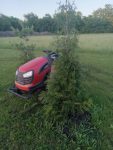 Once you have selected the type of tree you want, you can either order one, find one at a local nursery, or even transplant a wild tree, if appropriate. Beware of tree size! Really large trees (greater than 7 feet tall) tend to be more difficult to transplant and transport, and can endure significant shock during the transplanting experience. They are also expensive. Small trees are likely to be overwhelmed by surrounding vegetation. Many mailorder nurseries will sell trees that are little more than seedlings at two to three feet tall. If you have aggressive vegetation such as Johnson grass, these trees will take tons of care and may not succeed even with your best efforts. I have had moderate success with planting them in a tended garden space for two or three years to grow a bit, then transplanting them to their final location. But if you want something to grow more quickly and with less tending, buy a bigger tree. I have had good luck planting trees approximately the height and width of a standing man.
Once you have selected the type of tree you want, you can either order one, find one at a local nursery, or even transplant a wild tree, if appropriate. Beware of tree size! Really large trees (greater than 7 feet tall) tend to be more difficult to transplant and transport, and can endure significant shock during the transplanting experience. They are also expensive. Small trees are likely to be overwhelmed by surrounding vegetation. Many mailorder nurseries will sell trees that are little more than seedlings at two to three feet tall. If you have aggressive vegetation such as Johnson grass, these trees will take tons of care and may not succeed even with your best efforts. I have had moderate success with planting them in a tended garden space for two or three years to grow a bit, then transplanting them to their final location. But if you want something to grow more quickly and with less tending, buy a bigger tree. I have had good luck planting trees approximately the height and width of a standing man.
Now it is time to dig some holes! Have you measured your space? Follow all planting directions, or do some research about spacing for your chosen species. Do not put them any closer than recommended. Leave even more space than recommended if you can do so. Young trees are often unsuccessful due to competition with other, larger trees or even some aggressive grass species. For example, many pecan trees should be planted 40 feet apart. Evergreens such as Thule Green Giant Arborvitae can be planted as close as 10 feet apart, but it is better to give them 15 feet and make a staggered set of rows. For a shelter belt, plan to have rows of different species. For fruit and nut trees, consider which trees can pollinate each other, and your usual wind direction. Especially for nut trees such as pecans, which often come in “Type I” and “Type II” varieties with radically different pollen production and receptivity times, this can become complicated. Draw a diagram of your space, and plan carefully now so you can purchase during this coming winter.
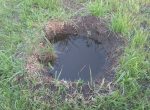 When you dig, make a nice, deep, wide hole, approximately 50 percent larger than the size of the roots of the tree you will be putting in. A large hole creates looser soil, to assist the tree with easy root growth during its first year. The first year is most difficult for a transplanted tree. As you dig the hole, remove all the rocks and roots that you find. If there are a lot of other tree roots in that space, you may have to dig out even farther, so that large established trees are not taking all the water and soil nutrients away from your newly planted tree. I prefer to dig these holes far in advance of planting time, because lowering several trees into the ground can take many hours. If there are weather problems or you have other chores to do, you might not have time or physical strength to do the entire job in a single day. However, there is a downside to doing this. You might go back to the hole you dug a few weeks or months ago, and find it full of water!
When you dig, make a nice, deep, wide hole, approximately 50 percent larger than the size of the roots of the tree you will be putting in. A large hole creates looser soil, to assist the tree with easy root growth during its first year. The first year is most difficult for a transplanted tree. As you dig the hole, remove all the rocks and roots that you find. If there are a lot of other tree roots in that space, you may have to dig out even farther, so that large established trees are not taking all the water and soil nutrients away from your newly planted tree. I prefer to dig these holes far in advance of planting time, because lowering several trees into the ground can take many hours. If there are weather problems or you have other chores to do, you might not have time or physical strength to do the entire job in a single day. However, there is a downside to doing this. You might go back to the hole you dug a few weeks or months ago, and find it full of water!
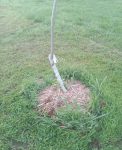 How you put the new tree in the hole will depend on if your tree was transplanted, came in a pot, or was ordered bare-root. To begin, put some fertilizer or aged manure in the bottom of your hole. Just a sprinkle of fertilizer, or perhaps a one-inch or two-inch layer of manure. Put a couple of shovels of soil on top, and wet it with a gallon or two of water. This will provide a soft, fertile base for the new tree. If your tree was ordered from a nursery bare-root, unwrap the roots at this point and moisten them. Put some soil in a bucket and make a thin mud slurry with some water. Dip the tree’s roots into this mud slurry so they are coated thoroughly. If the roots are too large to fit in a container, pour slurry over them. You can skip this process if your tree already has soil around the roots.
How you put the new tree in the hole will depend on if your tree was transplanted, came in a pot, or was ordered bare-root. To begin, put some fertilizer or aged manure in the bottom of your hole. Just a sprinkle of fertilizer, or perhaps a one-inch or two-inch layer of manure. Put a couple of shovels of soil on top, and wet it with a gallon or two of water. This will provide a soft, fertile base for the new tree. If your tree was ordered from a nursery bare-root, unwrap the roots at this point and moisten them. Put some soil in a bucket and make a thin mud slurry with some water. Dip the tree’s roots into this mud slurry so they are coated thoroughly. If the roots are too large to fit in a container, pour slurry over them. You can skip this process if your tree already has soil around the roots.
When you lower any tree into the hole, make sure that the roots are not broken or compressed. Begin to place soil around the roots, adding small amounts of fertilizer or manure, adding water as you go, and packing gently. Finish by stepping on the soil at ground level, and raking excess soil into a “dish” that can hold water. Finish with a mound of mulch, so you can keep grass at least twelve inches away from your new tree. More is better.
Once your trees are planted, it is time to protect them. Fruit trees especially require protection from deer, rabbits, and insects. Evergreen trees are less attractive to those pests, but might still require a wire cage around them during the first couple of years, to prevent damage from deer. Also watch for insects during the growing season, and find out what varieties of insects you have locally. Where I live, bagworms are always a problem for young trees, and June is a peak month for observation and spraying. For fruit trees, you will need to do more. It seems that every pest in the area is drawn to a fruit tree. To begin, I use a fabric tree wrap around the first few feet of trunk. This helps to prevent sun scald – a condition that happens during the winter when a tree has been frozen for days, and then suddenly warm weather appears. Wind the wrapping in a spiral firmly, but not too tight. This will need to be replaced every year or two as the wrapping degrades and the tree grows.
The wrapping also helps to protect the trunk from your next step, adding chicken wire. Wrap some chicken wire loosely around the trunk to protect it from gnawing rabbits and deer. The chicken wire also protects the trunk from the claws of barn cats who love to climb!
 When this is done, take an empty gallon jug and cut a large hole in the side. Hang this from a stake for small trees, or place between the lowest branches. Put a piece of banana peel in each, along with some water. Add a cup each of sugar and vinegar to the water. This creates a trap for codling moths and a few beetle species. You will want to watch this trap through the summer, replacing water and vinegar as necessary and removing dead insects.
When this is done, take an empty gallon jug and cut a large hole in the side. Hang this from a stake for small trees, or place between the lowest branches. Put a piece of banana peel in each, along with some water. Add a cup each of sugar and vinegar to the water. This creates a trap for codling moths and a few beetle species. You will want to watch this trap through the summer, replacing water and vinegar as necessary and removing dead insects.
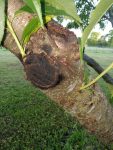 During the first year, and during any time in which the tree is growing, resist the urge to prune. Pruning is best done during the winter dormant season. During spring and summer, if branches are not growing correctly or are too low, mark them with some flagging tape, such as the orange or pink tape that surveyors use. Why do you want to mark them now? Branches are heavy with leaves and fruit at this time of year, and sag lower to the ground. In the winter, they are higher up due to a lightened load. When it is time to prune in the winter, use a sharp pruning shears to make a clean cut on smaller branches, or a saw with fine teeth for bigger ones. On all pruned spots larger than the diameter of your little finger, cover with a pruning spray. Most garden stores and nurseries sell small aerosol cans that look just like spray paint. Sometimes people use paint, but it is better to pay slightly more and get the correct stuff. It is usually necessary to prune fruit trees, while evergreen trees require only minimal tending.
During the first year, and during any time in which the tree is growing, resist the urge to prune. Pruning is best done during the winter dormant season. During spring and summer, if branches are not growing correctly or are too low, mark them with some flagging tape, such as the orange or pink tape that surveyors use. Why do you want to mark them now? Branches are heavy with leaves and fruit at this time of year, and sag lower to the ground. In the winter, they are higher up due to a lightened load. When it is time to prune in the winter, use a sharp pruning shears to make a clean cut on smaller branches, or a saw with fine teeth for bigger ones. On all pruned spots larger than the diameter of your little finger, cover with a pruning spray. Most garden stores and nurseries sell small aerosol cans that look just like spray paint. Sometimes people use paint, but it is better to pay slightly more and get the correct stuff. It is usually necessary to prune fruit trees, while evergreen trees require only minimal tending.
If you do not want to use chemical substances such as insecticides, it will be more difficult for you to raise fruit and keep pests away from both fruit trees and evergreen trees. Fungus will also be a problem, especially in the South. There are some options that are relatively natural. Diatomaceous earth can be sprinkled on the leaves of any tree, and it reduces insect damage by clogging up their digestive systems. You can get food-grade diatomaceous earth at many farm stores. Sprinkling on young trees and garden crops is easy, but reaching the higher branches of adult trees can pose a problem. Some people have used tall ladders, lift trucks, or even drones to dispense diatomaceous earth. I prefer not to use it, as I find it less effective than other methods.
 If you use chemical sprays, you can mix insecticide and fungicide together in the same spraying. Initially I was unsure of this, so I contacted the agricultural extension office of my state’s university system. You can find contact information for your local office quite easily online, and they are usually happy to answer all kinds of questions. Be aware that sprays will have specific instructions. Some are only usable at certain times of the year. For example, I spray copper sulfate twice during the winter – once in November or December and once in February. This is useful for preventing fungus. I also spray dormant oil in November, as this is also effective, and can be used in the same spraying session with the copper sulfate. Take note that dormant oil should not be used on most evergreen species. During the growing season, avoid spraying insecticide and fungicide on or near trees that have blossoms, as this can injure and kill large numbers of pollinators such as honeybees. Wait until you see fruit beginning to set.
If you use chemical sprays, you can mix insecticide and fungicide together in the same spraying. Initially I was unsure of this, so I contacted the agricultural extension office of my state’s university system. You can find contact information for your local office quite easily online, and they are usually happy to answer all kinds of questions. Be aware that sprays will have specific instructions. Some are only usable at certain times of the year. For example, I spray copper sulfate twice during the winter – once in November or December and once in February. This is useful for preventing fungus. I also spray dormant oil in November, as this is also effective, and can be used in the same spraying session with the copper sulfate. Take note that dormant oil should not be used on most evergreen species. During the growing season, avoid spraying insecticide and fungicide on or near trees that have blossoms, as this can injure and kill large numbers of pollinators such as honeybees. Wait until you see fruit beginning to set.
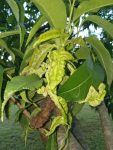 Most of the time, spraying needs to be done in advance of the problem. Once you see evidence of fungal damage, especially on leaves, it is usually too late to treat it. Plan your spraying carefully, and for fungal protection you will need to rotate the kind of spray you use. Fungi can develop resistance to a spray that is used too often, just like bacteria in humans can develop resistance to antibiotics. Follow instructions to the letter! Insects may be killed off by immediate spraying of insecticide, but often the damage is already done. Your fruit yield for that year may be reduced, or the tree might need to be replaced if the damage is severe.
Most of the time, spraying needs to be done in advance of the problem. Once you see evidence of fungal damage, especially on leaves, it is usually too late to treat it. Plan your spraying carefully, and for fungal protection you will need to rotate the kind of spray you use. Fungi can develop resistance to a spray that is used too often, just like bacteria in humans can develop resistance to antibiotics. Follow instructions to the letter! Insects may be killed off by immediate spraying of insecticide, but often the damage is already done. Your fruit yield for that year may be reduced, or the tree might need to be replaced if the damage is severe.
Take note if a tree attracts insects constantly, as this could be a problem for other trees in your area. I planted a plum tree years ago that never bore fruit, but constantly attracted Japanese beetles – a true pest! No matter how much I sprayed, that tree was like a magnet to them, and my orchard was full of squirming, eating, breeding bugs. Finally, I had to remove the plum tree and I will never plant another. Since then, the Japanese beetle problem in my orchard has been significantly reduced. The lesson that I learned is that some things are impossible to grow if pests will not leave them alone. Check your garden, orchard, and the rest of your property daily. What was not a problem yesterday can be a huge problem today, and a disaster tomorrow. Act quickly!
Since spring is almost over, the time for planting trees has passed for this year. But there is still plenty to do. There are actions you can take today to protect trees you already have – wrapping, trapping, spraying, and marking for future pruning. Now is also the time to prepare for next year. Find out which trees you want to plant this coming winter and spring. Measure, research, and plan. Now is the time!

